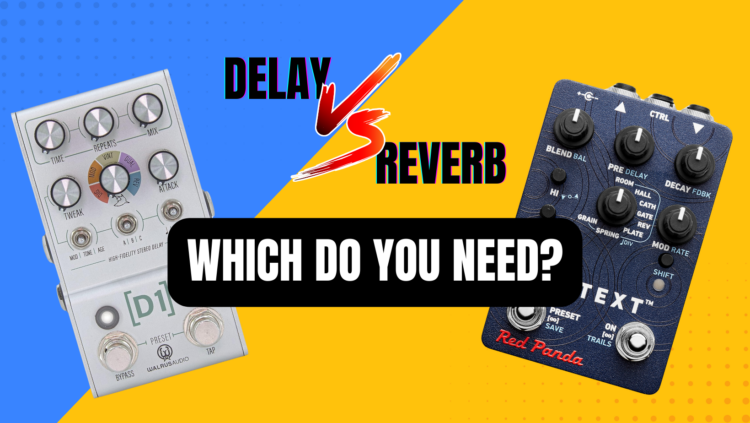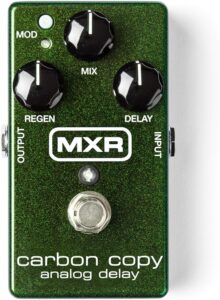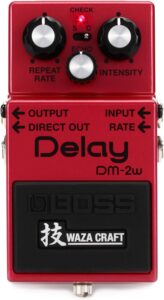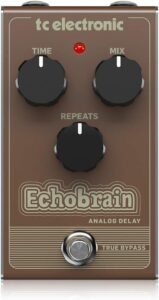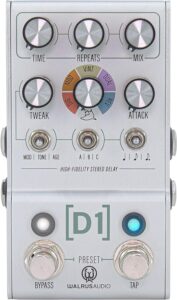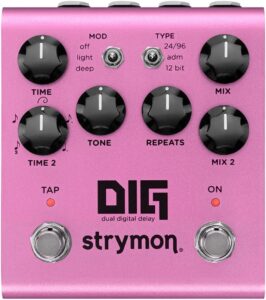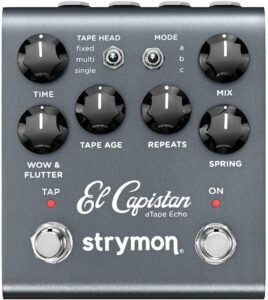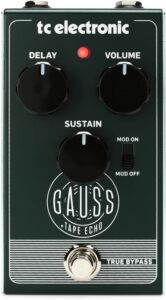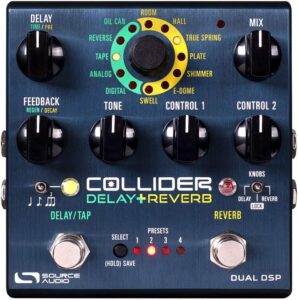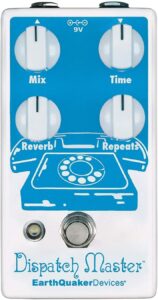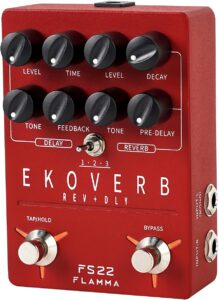This post may contain affiliate links
Whether you are buying your first guitar pedal or you’re a seasoned pedal enthusiast, you may find yourself asking if you need both a delay and a reverb pedal on your pedalboard.
While delay and reverb effects are similar, in that they both create space in between notes, the way they achieve this is quite different from one another. So let’s dive into both effects to find what’s right for you.
Understanding Delay Pedals
In the easiest terms, delay can be described as an echo. In the real world, delay (or echos) can happen naturally – we’ve all heard it – someone in a canyon yelling ‘hello!’ and the sound of their voice carries across the canyon, bounces off the other side of the canyon and the sound of their ‘hello’ comes back a moment later.
Delay pedals work to capture this same phenomenon, except you don’t need a massive canyon to get delay effects on the guitar. Instead, you use a delay pedal. When using a delay pedal, you play a note, and the delay pedal repeats the note. Except in delay pedals, you have far more control over the sound of the echos, as most delay pedals offer knobs to control the number of repeats that occur and the distance between them.
Delay pedals can help fill in the space between notes, and can be useful for various genres and guitar styles. They can help add a new character to your lead licks or help make your make your clean picking riffs more interesting.
Common Delay Pedal Controls
Most delay pedals will have three main controls to help shape your delay sound.
Volume – Controls how loud the delay’s repeats are.
Time – Controls the amount of time between each repeat.
Repeats – Controls the number of repeats that occur.
Of course, each manufacturer puts their own spin on things, and many delay pedals offer additional knobs to help dial in and tweak your delay sound.
Types of Delay Effects (Analog, Digital, Tape Delay)
There are quite a few different styles of delay pedals available today. Yet, the three main types of delay pedals you’re most likely to see are Analog delay. Digital delay. And Tape Delay. But what’s the difference between them?
What is Analog Delay?
Analog delay pedals use analog technology to create the delay effect. Most analog delay pedals use Bucket Brigade Device (BBD) chips to accomplish this. Your guitar signal is passed through the BBD chip inside of the delay pedal, which then delays the signal and mixes it back in – creating the echo effect.
Analog delay pedals have a distinct sound that many guitar pedal enthusiasts love. They tend to have a more warm, rich sound.
Check Out These Analog Delay Pedals
MXR – Carbon Copy
The Carbon Copy is a classic, no-nonsense analog delay pedal. It uses BBD technology to create its delay sounds and offers onboard modulation for some incredible delay tones.
View the Carbon Copy on Amazon
Boss – DM-2w
The DM-2w is an all-analog delay pedal that offers a ton of useful features including two different modes, wet and dry outputs, and expression pedal control.
TC Electronic – Echobrain
This budget-friendly analog delay pedal is a home run. The Echobrain utilizes bucket brigade technology and offers a useful set of controls for an incredible price.
What is Digital Delay
Digital delay is another very common type of delay pedal today. Digital delays take your guitar signal and convert it to a digital signal, which can then be processed, delayed, and sent to the output of the pedal. Because they utilize digital processing, the range of delay sounds you can get from a digital delay pedal is often more complex than their analog counterparts.
While many guitarists may still prefer analog delays over digital delays, the technology is constantly improving and today’s digital delay pedals are nothing short of incredible (some can even recreate very convincing ‘analog delay’ sounds in a digital environment).
Check Out These Digital Delay Pedals
Walrus Audio – MAKO Series D1
The D1 is a powerhouse of a delay pedal. Offering 5 tweakable delay algorithms in one small package.
View the MAKO Series D1 on Amazon
Strymon – Dig
Strymon is known for their amazing delay pedals, and the Dig is a fantastic digital delay. This dual delay offers three different delay modes, optional modulation, and a ton of control over your delay sound.
View the Dig on Amazon
What is Tape Delay
Tape delay pedals are made to emulate the sound of vintage tape echo machines. Tape echo machines were used to create the first-ever delay effects. They utilized tape and play heads to record and play back sounds to create an echo effect. Today, there are several Tape Delay pedals on the market – all aiming to recreate this beautiful, vintage delay sound.
Check Out These Tape Delay Pedals
The El Capistan is a widely used tape echo pedal. It offers massive amounts of control when it comes to tweaking the delay sound – from its three modes, different tape head options, and several knobs to adjust your sound.
View the El Capistan on Amazon
TC Electronic – Gauss Tape Echo
The Gauss Tape Echo is a fantastic, budget-friendly tape delay pedal.
View the Gauss Tape Echo on Amazon
Check out our full list of the best delay pedals if you need some further inspiration.
Understanding Reverb Pedals
Reverb is all around us. When a sound occurs in a space, sound waves are sent in all directions. Those waves will reflect off of different surfaces creating reverb. Think about being in an empty room and clapping your hands. The sound that you hear after the clap is reverb.
In the guitar pedal world, reverb pedals aim to recreate that same effect with the sound of your guitar. Reverb pedals are one of the most popular types of guitar pedals and they come in all different types – from subtle, more natural-sounding reverb effects to vast, spacious reverbs for ambient music.
Common Reverb Pedal Controls
Most reverb pedals will have two main controls to help shape your reverb sound.
Mix– Controls the volume balance between your clean signal and the reverb sound.
Decay – Controls how long the reverb sound lasts before decaying.
Types of Reverb Pedals
Many reverb pedals will offer a variety of different reverb types or algorithms. One pedal may have 6 or 7 different reverb types in one box. Of course, there are also standalone pedals for different reverb sounds, like Spring Reverb, if you’re only searching for one specific reverb style.
Some of the more common reverb types are:
Spring Reverb – One of the earliest forms of reverb is the spring reverb. This reverb technique utilizes actual springs and wire to add reverb to your sound. Your signal is played into one end of a spring and an output transducer at the other end of the spring captures the sound – creating reverb. Today, there are spring reverb pedals available that still utilize real springs in them, and spring reverb pedals that digitally recreate the iconic spring reverb sound.
Plate Reverb – Similar to a spring reverb, this early form of reverb utilized a large metal plate to create reverb. Your instrument’s signal would be passed through a large metal plate, causing the plate to vibrate and create reverb.
Room Reverb – A very natural, often subtle form of reverb that is made to recreate the reverb sound you would hear in an empty room.
There are a handful of other reverb types available, many are made to create reverb sounds based on different room sizes. For example, Hall reverb, or Cathedral reverb are meant to sound like the rooms they are named after.
Watch our demo of the Context 2 from Red Panda for a run-through of common reverb styles.
If you’re looking for the perfect reverb pedal, check out our list of the best reverb pedals.
Do You Need Both A Delay and A Reverb Pedal?
In a perfect world, you would have both effects on your pedalboard. A delay to create echoes and add interest to your playing – and a reverb pedal to add space and texture to your sound. Plus, they can be used at the same time (most often running the delay pedal into the reverb pedal) to create interesting sounds and ambiance.
But if budget or space on your pedalboard is an issue, it comes down to personal preference and what you need for the tones you are reaching for.
But you are not completely out of luck, because there are a lot of amazing two-in-one delay & reverb pedals available that give you the best of both worlds.
Check Out These 2-In-1 Delay and Reverb Pedals
Source Audio – Collider
If you’re looking for maximum control, the Collider from Source Audio is the answer. This delay+reverb pedal offers tons of controls to tweak its 5 delay algorithms and 7 reverb algorithms. The delay and reverb can be used separately or together in unison.
Earthquaker Devices – Dispatch Master
The Dispatch Master is a compact delay and reverb pedal that can fit on virtually any pedalboard. It can be used as a delay pedal only, a reverb pedal only, or with both effects combined.
View the Dispatch Master on Amazon
Flamma – Ekoverb
The Ekoverb from Flamma is the perfect budget-friendly option for a 2-in-1 delay and reverb pedal. Despite its small price tag, the Ekoverb offers a lot for its price – including stereo ins and outs, and 3 pairs of delay and reverb effects.

